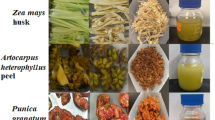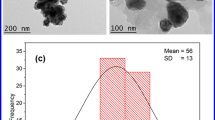Abstract
Selenium nanoparticles (SeNPs) were successfully synthesized using the culture extract of Monascus purpureus ATCC16436 grown on sugarcane bagasse under solid-state fermentation. The rapid synthesis of SeNPs was completed after 30 min as confirmed by UV–Vis spectroscopy. Functional groups present in the synthesized SeNPs samples were confirmed by Fourier transform infrared spectroscopy. The synthesized SeNPs showed a single-phase crystalline structure. Transmission electron microscope revealed the spherical shape and the mean particle size was 46.58 nm. Dynamic light scattering analysis showed that the synthesized SeNPs were monodispersed and the recorded polydispersity index value was 0.205. Zeta potential value of − 24.01 mV indicated the high stability of SeNPs. Besides, the biological activities of antioxidant, anticancer and antimicrobial as well as the photocatalytic activities were also studied. SeNPs showed promising antioxidant activity with 50% inhibitory concentration of 85.92 µg mL−1. Based on the MTT assay, SeNPs inhibited the proliferation of normal human melanocytes, human breast and liver cancer cell lines with 50% inhibitory concentrations of 45.21, 61.86 and 200.15 µg mL−1, respectively. SeNPs showed broad spectrum of antimicrobial potential against the tested human and plant pathogens. SeNPs showed efficient degradation of methylene blue dye. Moreover, the effect of gamma irradiation on the production enhancement of SeNPs was also adopted. Exposure of the fungal spores to gamma rays at 1000 Gy increased the yield of SeNPs to approximately fivefold. Hence, this study suggests a new and alternate approach with the excellent biotechnological potentiality for the production of SeNPs.






Similar content being viewed by others
References
Fardsadegh B, Jafarizadeh-Malmiri H (2019) Aloe vera leaf extract mediated green synthesis of selenium nanoparticles and assessment of their in vitro antimicrobial activity against spoilage fungi and pathogenic bacteria strains. Green Process Synth 8:399–407. https://doi.org/10.1515/gps-2019-0007
Wadhwani SA, Shedbalkar UU, Singh R, Chopade BA (2016) Biogenic selenium nanoparticles: current status and future prospects. Appl Microbiol Biotechnol 100:2555–2566. https://doi.org/10.1007/s00253-016-7300-7
Zhang J, Wang H, Yan X, Zhang L (2005) Comparison of short term toxicity between nano-Se and selenite in mice. Life Sci 76:1099–1109. https://doi.org/10.1016/j.lfs.2004.08.015
Shirsat S, Kadam A, Naushad M, Mane RS (2015) Selenium nanostructures: microbial synthesis and applications. RSC Adv 5:92799–92811. https://doi.org/10.1039/C5RA17921A
Barnaby S, Frayne S, Fath K, Banerjee I (2011) Growth of Se nanoparticles on kinetin assemblies and their biocompatibility studies. Soft Mater 9:313–334. https://doi.org/10.1080/1539445X.2010.516302
Srivastava N, Mukhopadhyay M (2013) Biosynthesis and structural characterization of selenium nanoparticles mediated by Zooglea ramigera. Powder Technol 244:26–29. https://doi.org/10.1016/j.powtec.2013.03.050
Zhang J, Spallholz J (2011) Toxicity of selenium compounds and nanoselenium particles. Gen Appl Syst Toxicol. https://doi.org/10.1002/9780470744307.gat243
Zhang H, Zhou H, Bai J, Li Y, Yang J, Ma Q, Qu Y (2019) Biosynthesis of selenium nanoparticles mediated by fungus Mariannaea sp. HJ and their characterization. Colloids Surf A Physicochem Eng Asp 571:9–16. https://doi.org/10.1016/j.colsurfa.2019.02.070
Dorcheh SK, Vahabi K (2016) Biosynthesis of nanoparticles by fungi: large-scale production. In: Mérillon JM, Ramawat K (eds) Phytochemistry. Springer, Dordrecht. https://doi.org/10.1007/978-3-319-19456-1_8-1
Agboyibor C, Kong W, Chen D, Zhang A, Niu S (2018) Monascus pigments production, composition, bioactivity and its application: a review. Biocatal Agric Biotechnol 16:433–447. https://doi.org/10.1016/j.bcab.2018.09.012
El-Sayed ER, Ahmed AS, Ismaiel AA (2019) Agro-industrial byproducts for production of the immunosuppressant mycophenolic acid by Penicillium roqueforti under solid-state fermentation: enhanced production by ultraviolet and gamma irradiation. Biocatal Agric Biotechnol 18:101015. https://doi.org/10.1016/j.bcab.2019.01.053
Thaipong K, Boonprakob U, Crosby K, Cisneros-Zevallos L, Byrne DH (2006) Comparison of ABTS, DPPH, FRAP, and ORAC assays for estimating antioxidant activity from guava fruit extracts. J Food Compos Anal 19:669–675. https://doi.org/10.1016/j.jfca.2006.01.003
Ismaiel AA, Ahmed AS, Hassan IA, El-Sayed ER, Karam El-Din AA (2017) Production of paclitaxel with anticancer activity by two local fungal endophytes, Aspergillus fumigatus and Alternaria tenuissima. Appl Microbiol Biotechnol 101:5831–5846. https://doi.org/10.1007/s00253-017-8354-x
El-Sayed ER, Abdelhakim HK, Zakaria Z (2020) Extracellular biosynthesis of cobalt ferrite nanoparticles by Monascus purpureus and their antioxidant, anticancer and antimicrobial activities: yield enhancement by gamma irradiation. Mater Sci Eng C 107:110318
Udayabhanu Nagaraju G, Nagabhushana H, Basavaraj RB, Raghu GK, Suresh D, Rajanaika H, Sharma SC (2016) Green, non chemical route for the synthesis of ZnO superstructures, evaluation of its applications towards photocatalysis, photoluminescence and bio-sensing. Cryst Growth Des 16:6828–6840. https://doi.org/10.1021/acs.cgd.6b00936
Li Y, Li X, Wong Y, Chen T, Zhang H, Liu C, Zheng W (2011) The reversal of cisplatin-induced nephrotoxicity by selenium nanoparticles functionalized with 11-mercapto-1-undecanol by inhibition of ROS-mediated apoptosis. Biomaterials 32:9068–9076. https://doi.org/10.1016/j.biomaterials.2011.08.001
Dhanjal S, Cameotra SS (2010) Aerobic biogenesis of selenium nanospheres by Bacillus cereus isolated from coalmine soil. Microb Cell Fact 9:52. https://doi.org/10.1186/1475-2859-9-52
Shirsat S, Kadam A, Mane RS, Jadhav VV, Zate MK, Naushade M, Kim KH (2016) Protective role of biogenic selenium nanoparticles in immunological and oxidative stress generated by enrofloxacin in broiler chicken. Dalton Trans 45:8845–8853. https://doi.org/10.1039/C6DT00120C
El-Baz AF, El-Batal AI, Abomosalam AF, Tayel AA, Shetaia YM, Yang S (2015) Extracellular biosynthesis of anti-Candida silver nanoparticles using Monascus purpureus. J Basic Microbiol 56:531–540. https://doi.org/10.1002/jobm.201500503
Koli SH, Mohite BV, Borase HP, Patil SV (2017) Monascus pigments mediated rapid green synthesis and characterization of gold nanoparticles with possible mechanism. J Clust Sci 28:2719–2732. https://doi.org/10.1007/s10876-017-1254-5
Mosallam FM, El-Sayyad GS, Fathy RM, El-Batal AI (2018) Biomolecules-mediated synthesis of selenium nanoparticles using Aspergillus oryzae fermented lupin extract and gamma radiation for hindering the growth of some multidrug-resistant bacteria and pathogenic fungi. Microb Pathog 122:108–116. https://doi.org/10.1016/j.micpath.2018.06.013
Arakelova ER, Grigoryan SG, Arsenyan FG, Babayan NS, Grigoryan RM, Sarkisyan NK (2014) In vitro and in vivo anticancer activity of nanosize zinc oxide composites of doxorubicin. Int J Mol Chem Eng 8:33–38. https://doi.org/10.5281/zenodo.1336921
Butler C, Debieux C, Dridge E, Splatt P, Wright M (2012) Biomineralization of selenium by the selenate-respiring bacterium Thauera selenatis. Biochem Soc Trans 40:1239–1243. https://doi.org/10.1042/BST20120087
Liang X, Perez MAM, Nwoko KC, Egbers P, Feldmann J, Csetenyi L, Gadd GM (2019) Fungal formation of selenium and tellurium nanoparticles. Appl Microbiol Biotechnol 103:7241–7259. https://doi.org/10.1007/s00253-019-09995-6
Vetchinkina E, Loshchinina E, Kursky V, Nikitina V (2013) Reduction of organic and inorganic selenium compounds by the edible medicinal basidiomycete Lentinula edodes and the accumulation of elemental selenium nanoparticles in its mycelium. J Microbiol 51:829–835. https://doi.org/10.1007/s12275-013-2689-5
Zare B, Babaie S, Setayesh N, Shahverdi AR (2013) Isolation and characterization of a fungus for extracellular synthesis of small selenium nanoparticles. Nanomed J 1:13–19. https://doi.org/10.7508/nmj.2013.01.002
Sarkar J, Dey P, Saha S, Acharya K (2011) Mycosynthesis of selenium nanoparticles. Micro Nano Lett 6:599–602. https://doi.org/10.1049/mnl.2011.0227
Gharieb MM, Wilkinson SC, Gadd GM (1995) Reduction of selenium oxyanions by unicellular, polymorphic and filamentous fungi: cellular location of reduced selenium and implications for tolerance. J Ind Microbiol 14:300–311. https://doi.org/10.1007/BF01569943
Kovacic P, Somanathan R (2013) Nanoparticles: toxicity, radicals, electron transfer, and antioxidants. Methods Mol Biol 1028:15–35. https://doi.org/10.1007/978-1-62703-475-3_2
Das D, Nath BC, Phukon P, Dolui SK (2013) Synthesis of ZnO nanoparticles and evaluation of antioxidant and cytotoxic activity. Colloids Surf B Biointerfaces 111:556–560. https://doi.org/10.1016/j.colsurfb.2013.06.041
Alagesan V, Venugopal S (2019) Green synthesis of selenium nanoparticle using leaves extract of Withania somnifera and its biological applications and photocatalytic activities. BioNanoScience 9:105–116. https://doi.org/10.1007/s12668-018-0566-8
Torres SK, Campos VL, Leon CG, Rodriguez-Llamazares SM, Rojas SM, Gonzalez M, Smith C, Mondaca MA (2012) Biosynthesis of selenium nanoparticles by Pantoea agglomerans and their antioxidant activity. J Nanopart Res 14:1236. https://doi.org/10.1007/s11051-012-1236-3
Chen T, Wong YS, Zheng W, Bai Y, Huang L (2008) Selenium nanoparticles fabricated in Undaria pinnatifida polysaccharide solutions induce mitochondria-mediated apoptosis in A375 human melanoma cells. Colloids Surf B Biointerfaces 67:26–31. https://doi.org/10.1016/j.colsurfb.2008.07.010
Luo H, Wang F, Bai Y, Chen T, Zheng W (2012) Selenium nanoparticles inhibit the growth of HeLa and MDA-MB-231 cells through induction of S phase arrest. Colloids Surf B Biointerfaces 94:304–308. https://doi.org/10.1016/j.colsurfb.2012.02.006
Zheng JS, Zheng SY, Zhang YB, Yu B, Zheng WJ, Yang F, Chen TF (2010) Sialic acid surface decoration enhances cellular uptake and apoptosis-inducing activity of selenium nanoparticles. Colloids Surf B Biointerfaces 83:183–187. https://doi.org/10.1016/j.colsurfb.2010.11.023
Srivastava P, Braganca JM, Kowshik M (2014) In vivo synthesis of selenium nanoparticles by Halococcus salifodinae BK18 and their anti-proliferative properties against HeLa cell line. Biotechnol Prog 30:1480–1487. https://doi.org/10.1002/btpr.1992
Kong L, Yuan Q, Zhu H, Li Y, Guo Q, Wang Q, Bi X, Gao X (2011) The suppression of prostate LNCaP cancer cells growth by selenium nanoparticles through Akt/Mdm2/AR controlled apoptosis. Biomaterials 32:6515–6522. https://doi.org/10.1016/j.biomaterials
Vekariya KK, Kaur J, Tikoo K (2012) ERα signaling imparts chemotherapeutic selectivity to selenium nanoparticles in breast cancer. Nanomed 8:1125–1132. https://doi.org/10.1016/j.nano.2011.12.003
Srivastava N, Mukhopadhyay M (2015) Green synthesis and structural characterization of selenium nanoparticles and assessment of their antimicrobial property. Bioprocess Biosyst Eng 38:1723–1730. https://doi.org/10.1007/s00449-015-1413-8
Shubharani R, Mahesh M, Murthy VNY (2019) Biosynthesis and characterization, antioxidant and antimicrobial activities of selenium nanoparticles from ethanol extract of Bee Propolis. J Nanomed Nanotechnol 10:1. https://doi.org/10.4172/2157-7439.1000522
Dutta RK, Nenavathu BP, Gangishetty MK, Reddy AVR (2012) Studies on antibacterial activity of ZnO nanoparticles by ROS induced lipid peroxidation. Colloids Surf B Biointerfaces 94:143–150. https://doi.org/10.1016/j.colsurfb.2012.01.046
Zhang L, Jiang Y, Ding Y, Povey M, York D (2007) Investigation into the antibacterial behaviour of suspensions of ZnO nanoparticles (ZnO nanofluids). J Nanopart Res 9:479–489. https://doi.org/10.1007/s11051-006-9150-1
Chiou YD, Hsu YJ (2011) Room-temperature synthesis of single-crystalline Se nanorods with remarkable photocatalytic properties. Appl Catal B Environ 105:211–219. https://doi.org/10.1016/j.apcatb.2011.04.019
Yang LB, Shen YH, Xie AJ, Liang JJ, Zhang BC (2008) Synthesis of Se nanoparticles by using TSA ion and its photocatalytic application for decolorization of cango red under UV irradiation. Mater Res Bull 43:572–582. https://doi.org/10.1016/j.materresbull.2007.04.012
Ismaiel AA, Ahmed AS, El-Sayed ER (2014) Optimization of submerged fermentation conditions for immunosuppressant mycophenolic acid production by Penicillium roqueforti isolated from blue-molded cheeses: enhanced production by ultraviolet and gamma irradiation. World J Microbiol Biotechnol 30:2625–2638. https://doi.org/10.1007/s11274-014-1685-1
Ismaiel AA, Ahmed AS, El-Sayed ER (2015) Immobilization technique for enhanced production of the immunosuppressant mycophenolic acid by ultraviolet and gamma-irradiated Penicillium roqueforti. J Appl Microbiol 119:112–126. https://doi.org/10.1111/jam.12828
El-Sayed ER, Ahmed AS, Hassan IA, Ismaiel AA, Karam El-Din AA (2019) Strain improvement and immobilization technique for enhanced production of the anticancer drug paclitaxel by Aspergillus fumigatus and Alternaria tenuissima. Appl Microbiol Biotechnol. https://doi.org/10.1007/s00253-019-10129-1
El-Sayed ER, Ismaiel AA, Ahmed AS, Hassan IA, Karam El-Din AA (2019) Bioprocess optimization using response surface methodology for production of the anticancer drug taxol by Aspergillus fumigatus and Alternaria tenuissima: enhanced production by ultraviolet and gamma irradiation. Biocatal Agric Biotechnol 18:100966. https://doi.org/10.1016/j.bcab.2019.01.034
El-Sayed ER, Ashraf AS, Abdelhakim HKZ (2019) A novel source of the cardiac glycoside digoxin from the endophytic fungus Epicoccum nigrum: isolation, characterization, production enhancement by gamma irradiation mutagenesis and anticancer activity evaluation. J Appl Microbiol. https://doi.org/10.1111/jam.14510C
Acknowledgements
We thank Dr. Aya M. Kamal, Assistant Lecturer, Nuclear Research Center, Atomic Energy Authority of Egypt for her sincere help.
Author information
Authors and Affiliations
Corresponding author
Ethics declarations
Conflict of interest
The authors declare that they have no conflicts of interest.
Ethical approval
This article does not contain any studies with human participants or animals performed by the authors.
Additional information
Publisher's Note
Springer Nature remains neutral with regard to jurisdictional claims in published maps and institutional affiliations.
Rights and permissions
About this article
Cite this article
El-Sayed, ES.R., Abdelhakim, H.K. & Ahmed, A.S. Solid-state fermentation for enhanced production of selenium nanoparticles by gamma-irradiated Monascus purpureus and their biological evaluation and photocatalytic activities. Bioprocess Biosyst Eng 43, 797–809 (2020). https://doi.org/10.1007/s00449-019-02275-7
Received:
Accepted:
Published:
Issue Date:
DOI: https://doi.org/10.1007/s00449-019-02275-7




